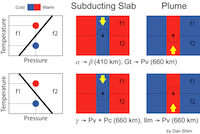
 |
Effects of positive (top) and negative (bottom) Clapeyron slope of phase transitions on mantle convection. The left column shows pressure-temperature phase diagrams (f1: low pressure less dense phase, f2: high pressure more dense phase, red dot: temperature at warm regions of the mantle, blue dot: temperature at cold regions of the mantle). The center column shows situations for subducting slabs. Red regions represent warmer mantle, while blue regions represent subducting slabs. A phase transition occurs at a shallower depth if the Clapeyron slope has a positive sign (top) but at a deeper depth if the Clapeyron slope has a negative sign in the cold subducting slab comapred with the normal mantle. Because cold high pressure phase is surrounded by warm low pressure phase for the case of positive Clapeyron slope, subducting slab goes through the phase boundary without resistance. However, in the case of negative Clapeyron slope, cold less dense material is surrounded by warm high pressure phase just below the phase boundary depth and therefore the negative Clapeyron slope behaves as a barrier for the downgoing subducting slab. The right column shows the cases for the warm plume surrounded by relatively cold mantle [full size]. |
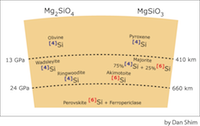 |
This diagram shows how the coordination number of Si increases with pressure in different minerals in the mantle. Related discussion can be found in S.-H. Shim and K. Catalli (2009) Compositional dependence of structural transition pressures in amorphous phases with mantle-related compositions. Earth and Planetary Science Letters 283, 174-180 [full size]. |
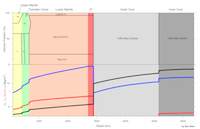 |
Mineralogy (top) and seismic properties (bottom) of the Earth's interior [full size]. |
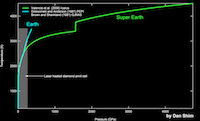 |
Pressure, temperature conditions of the interiors of Earth (blue) and 10-earth-mass super-Earth (green). For detail, read B. Grocholski, S.-H. Shim, and V. B. Prakapenka (2010) Stability of the MgSiO3 analog NaMgF3 and its implication for mantle structure in super-Earths. Geophysical Research Letters 37, L14204 [full size]. |
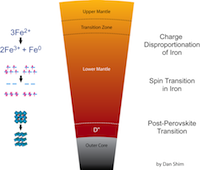 |
Three major transitions found recently in the lower mantle minerals. At pressures related to the topmost lower mantle, ferrous iron may undergoe charge disproportionation to ferric iron, which still remains in perovskite, and metallic iron, which may precipitate out from perovskite. At mid mantle pressures, iron undergoes changes in its electronic configuration. At the lowermost mantle, silicate perovskite undergoes a transition to post-perovskite. Related discussions can be found in S.-H. Shim (2008) The postperovskite transition. Annual Review of Earth and Planetary Sciences 36, 569-599 [full size]. |
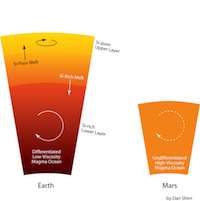 |
We found that Si-rich glass (MgSiO3) undergoes a transition to a dense structure at lower pressure than Si-poor glass (Mg2SiO4). If this occurs in melts, the compositional dependence of the structural transition may result in chemical differentiation of the magma ocean of the early Earth, while Mars magma ocean would be too shallow to have this effect. For more discussions, read S.-H. Shim and K. Catalli (2009) Compositional dependence of structural transition pressures in amorphous phases with mantle-related compositions. Earth and Planetary Science Letters 283, 174-180 [full size]. |
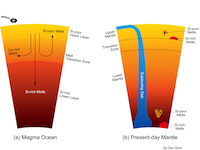 |
We found that Si-rich glass undergoes a transition to a dense structure at lower pressure than Si-poor glass. If this occurs in melts, the compositional dependence of the structural transition may result in chemical differentiation of the magma ocean of the early Earth such that the lower mantle is enriched in Si compared with the upper mantle. Also this might make Si-poor melts grativationally less stable than Si-rich melts in the present-day mantle. For more discussions, read S.-H. Shim and K. Catalli (2009) Compositional dependence of structural transition pressures in amorphous phases with mantle-related compositions. Earth and Planetary Science Letters 283, 174-180 [full size]. |
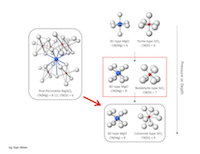 |
Some first-priinciples studies suggested that MgSiO3 breaks down to MgO and SiO2 at the pressure related to the deep interior of super-earths. We found that the breakdown pressure can be significantly higher than the prediction because of existence of intermediate coordiation state (red boxed) of Si. For detail, read B. Grocholski, S.-H. Shim, and V. B. Prakapenka (2010) Stability of the MgSiO3 analog NaMgF3 and its implication for mantle structure in super-Earths. Geophysical Research Letters 37, L14204 [full size]. |
 |
Magnetic structure of the post-perovskite phase in Fe2O3. (+) and (-) indicate directions of spins (ups and downs). Blue octahedra are 6-fold coordinated Fe and O units and brown bipolar prisms are 8-fold coordinated Fe and O units. For detail, read S.-H. Shim, A. Bengtson, D. Morgan, W. Sturhahn, K. Catalli, J. Zhao, M. Lerche, and V. B. Prakapenka (2009) Electronic and magnetic structures of the postperovskite-type Fe2O3 - Implications for planetary magnetic records and deep interior transitions. Proceedings of the National Academy of Sciences 106, 5508-5512 [full size]. |
 |
Magnetic orderings in different high-pressure phases of Fe2O3. (Left) hematite, (Center) Rh2O3-II type, and (Right) post-perovskite type. For detail, read S.-H. Shim, A. Bengtson, D. Morgan, W. Sturhahn, K. Catalli, J. Zhao, M. Lerche, and V. B. Prakapenka (2009) Electronic and magnetic structures of the postperovskite-type Fe2O3 - Implications for planetary magnetic records and deep interior transitions. Proceedings of the National Academy of Sciences 106, 5508-5512 [full size]. |
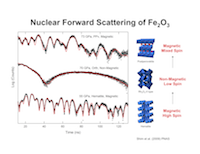 |
Nuclear forward scattering of different high pressure polymorphs of Fe2O3, demonstrating strong coupling between crystal structure and magnetic ordering. For detail, read S.-H. Shim, A. Bengtson, D. Morgan, W. Sturhahn, K. Catalli, J. Zhao, M. Lerche, and V. B. Prakapenka (2009) Electronic and magnetic structures of the postperovskite-type Fe2O3 - Implications for planetary magnetic records and deep interior transitions. Proceedings of the National Academy of Sciences 106, 5508-5512 [full size]. |
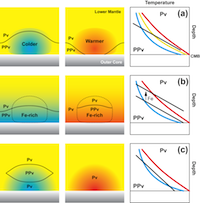 |
Changes in the depth of the post-perovskite phase transition in the lowermost mantle. Figure caption and detailed discussion can be found in S.-H. Shim (2008) The postperovskite transition. Annual Review of Earth and Planetary Sciences 36, 569-599 [full size]. |
Last updated: 08/05/2010 3:50 PM